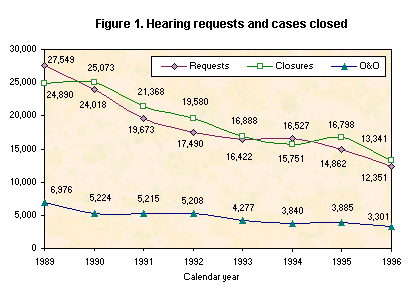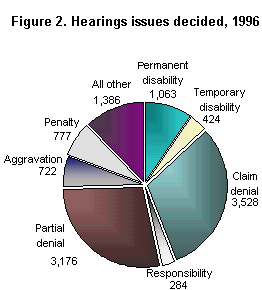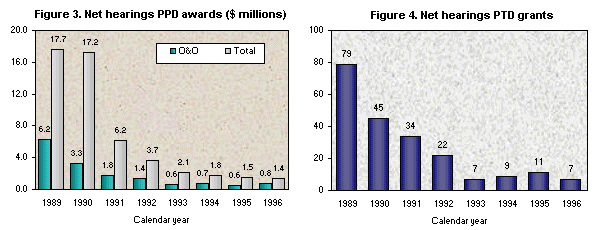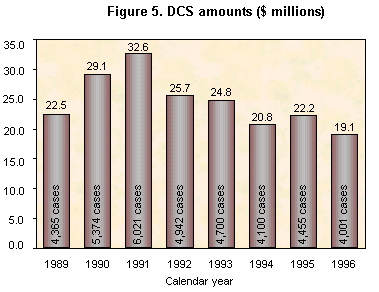
Requests. The Oregon Workers’ Compensation Board’s Hearings Division received 12,351 hearing requests on workers’ compensation in 1996 (including 859 stipulations received without a prior hearing request). That’s a decrease of over 2,500 (16.9 percent) from the previous year and the fewest requests since 1983. See Figure 1.
 Closures.
In 1996 the Hearings Division issued 13,341 closing orders on workers’
compensation cases, 20.6 percent fewer than in 1995.
Closures.
In 1996 the Hearings Division issued 13,341 closing orders on workers’
compensation cases, 20.6 percent fewer than in 1995.
Notes: Safety cases are excluded from this report. The data below, except Figure 1, include only cases involving claimant compensation (the right to receive it, or the amount thereof) or directly related issues, so cases dealing solely with noncomplying status or civil penalty are excluded. Discussions of issues and their dispositions apply to opinion and order (O&O) and stipulation cases only. Stipulations include disputed claim settlements (DCSs).
The breakout of closing orders by order type was as follows: 3,278 O&O’s (24.9 percent); 5,960 stipulations (45.2 percent, the lowest percentage on record); 3,929 dismissals and withdrawals (29.8 percent, second-highest value after 1995’s 30.3 percent); and 9 arbitrator’s decisions (0.1 percent, for only two responsibility disputes).
SAIF was the insurer in 35.0 percent of the cases, the fifth consecutive record-low value. Private insurers accounted for 48.3 percent, and self-insured employers 16.2 percent. The worker was the hearing requester in a typical 90.8 percent of the cases.
Issues. Figure 2 depicts the number of issues resolved at hearings. Claim denial was the most frequent issue, with 38.2 percent of the cases. Partial denial was an issue in a record-high 34.4 percent of the cases, while extent of temporary disability was involved in only 4.6 percent. O&O disposed of an average of 1.4 issues per case.
 Permanent
disability. The number of cases with this issue was 1,063,
11.5 percent of all cases. The percentage of cases granting an increase
in disability was 54.3 percent, the average permanent partial disability
(PPD) increase was 18.5 degrees, the number of permanent total disability
(PTD) grants was 7, and the net PPD awarded (sum of increases, less decreases)
was $1.4 million (Figure 3). These measures of permanent disability activity
are record-low or near-record-low values. All of the PTD grants were by
O&O. There were no PTD affirmations or rescissions, so the net number
of PTD grants was seven (Figure 4). Permanent
disability. The number of cases with this issue was 1,063,
11.5 percent of all cases. The percentage of cases granting an increase
in disability was 54.3 percent, the average permanent partial disability
(PPD) increase was 18.5 degrees, the number of permanent total disability
(PTD) grants was 7, and the net PPD awarded (sum of increases, less decreases)
was $1.4 million (Figure 3). These measures of permanent disability activity
are record-low or near-record-low values. All of the PTD grants were by
O&O. There were no PTD affirmations or rescissions, so the net number
of PTD grants was seven (Figure 4). |

Issue dispositions. The percentages of O&O cases decided in favor of the worker (all figures are percent) were as follows: permanent disability, 48.8 (almost 5 percentage points above the figure for 1995); temporary disability, 58.4; claim denial, 41.4 (lowest percentage on record); aggravation, 35.9; partial denial, 48.2; premature closure, 28.9 (over 17 percentage points below the previous lowest value); insurer penalty, 43.5; and claimant attorney fees, 48.2. For the disability issues, the above percentages reflect award increases (40.7 and 56.3 percent for permanent and temporary disability, respectively) plus insurer or employer hearing requests where the disability award is affirmed.
Disputed claim settlements. Figure 5 depicts the total value of DCSs, amounts paid to workers as consideration for not contesting a denial. Claim denial (excluding aggravation) was the issue in a record-low 47.0 percent of the 4,001 cases in 1996. The average DCS amount was $4,770.
 Time
Lags. For all O&O cases, the median time from hearing
request to order was 156 days (5.1 months), six days shorter than in 1995.
For O&O cases without a postponement, the median request-to-order time
lag was only 115 days.
Time
Lags. For all O&O cases, the median time from hearing
request to order was 156 days (5.1 months), six days shorter than in 1995.
For O&O cases without a postponement, the median request-to-order time
lag was only 115 days.
Attorney Fees. Fees awarded to workers’ attorneys totaled $9.1 million, 16.2 percent less than in 1995 and the lowest total since 1985. The average fee was $1,376. About 49.2 percent of the fees were paid out of claimant compensation.
Mediation activity. To help settle disputes without litigation, administrative law judges completed 128 mediations during the last seven months of 1996. About 84.4 percent resulted in settlement. Four-fifths of the settlements were DCSs. The average mediation was held 21 days after the request, with the closing order issued 46 days after the mediation (these values are medians).
| DCBS Public Home Page | IMD Home Page | Site Search Engine |
If you have questions about the information contained in this document please contact by e-mail or phone:Russell Reed, Research Analyst, Research & Analysis Section, Information Management Division (503) 947-7343.
This document was originally published in September 1997.
Document URL: http://www.cbs.state.or.us/external/imd/rasums/6_2106s.htm
[Printed form: 440-2106(9/97/IMD)]
In compliance with the Americans with Disabilities Act (ADA), this publication is available in alternative formats by calling (503) 378-8254 (V/TTY).
The information in IMD publications is in the public domain and may be reprinted without permission.